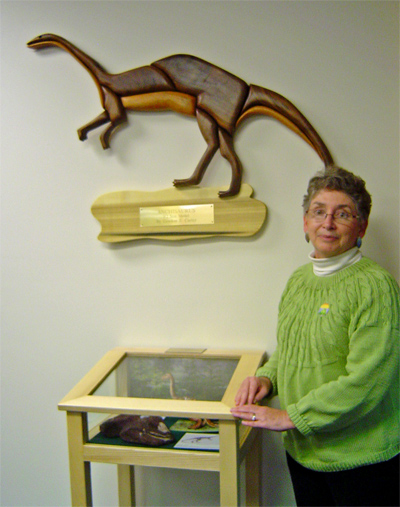Dinosaur comes home to East Windsor
East Windsor, CT--As discoveries of dinosaur bones go few are more distinguished. Yet, if not for folks like the local residents who gathered here at the Library at Warehouse Point on Sunday, The Bones from the Well might just as well be buried all over again.

Nancy Masters (above) stands next to the new display of casts of The Bones from the Well and a wooden sculpture of Anchisaurus that were unveiled at the Library at Warehouse Point on Sunday. The displays were dedicated in recognition of her twenty-five years of service as a member of the library's board. Ms. Masters resides at the site where the bones were first discovered nearly two centuries ago. She hopes that in addition to its new library display, East Windsor will one day have road signs commemorating its dinosaur as well. (Photo courtesy of Charlotte Foley.)
Few in Connecticut--and for that matter the world--have ever heard of The Bones from the Well. Even among paleontologists there are those who are ignorant about East Windsor’s fossils and the role they continue to play in the progress of dinosaur science.
Fragments of the forelimbs of a small plant-eating dinosaur that lived early in the of the Age of Dinosaurs, The Bones from the Well stand as the earliest verifiable discovery of dinosaur bones in North America. They remain as little more than chalk marks in the sandstone, but have been the subject of continual study from the time they were first unearthed in 1818.
Unfortunately, it wasn’t until 1896 that famed Yale Peabody Museum curator O. C. Marsh first pronounced the bones to be those of a prosauropod dinosaur—a delay that contributed to the bones languishing in obscurity ever since.
Despite the fact that Benjamin Silliman first published accounts of the discovery of the bones in his American Journal of Science in 1820, and that the latest in a long series of studies of the bones was published by paleontologist Adam Yates just three years ago in 2004, The Bones from the Well have until now been largely forgotten.
The glory of having made the first scientific description of dinosaurs went instead to Sir Richard Owen--an Englishman with the disdainful countenance of a mad scientist and a personality to go with it. Owen first coined the term dinosaur (fearfully great reptile) in 1842, based on fossils found in Britain.
That’s not to say that Owen, who was renowned for his ability to reconstruct previously unknown animals, as he did with a six-foot tall extinct bird known as Dinornis with nothing more than a six-inch fragment of its leg bone, doesn’t deserve recognition for many extraordinary accomplishments.
Rather, it is to argue that the impacts of many local discoveries, and the contributions of local scientists such as Benjamin Silliman and Edward Hitchcock are too often unrecognized—or even unknown.
If not for the interest of folks in East Windsor, the facts about how Connecticut Valley dinosaurs shed light on the greatest beasts ever to walk the earth might not see the light of day.
Few would hear about how the dinosaur-bird connection has its roots in the valley and the work of local scientists such as Edward Hitchcock. We might not recognize that proof that birds are dinosaurs came from New Haven with studies made by former Yale Peabody Museum curator John Ostrom or that Ostrom's findings were confirmed by his successor, Prof. Jacques Gauthier, using modern methods.
Thanks to The Library Association at Warehouse Point and its supporters, such as Nancy Masters, (casts of) The Bones from the Well can be found in East Windsor again--for the first time in nearly two hundred years. If you ask, they’ll be happy to tell you the story.
Editor’s Note: Casts are also on display at Dinosaur State Park in Rocky Hill, near the side door to the auditorium. The actual fossils are in the collection of the Yale Peabody Museum of Natural History, identified by the catalog number YPM 2125.